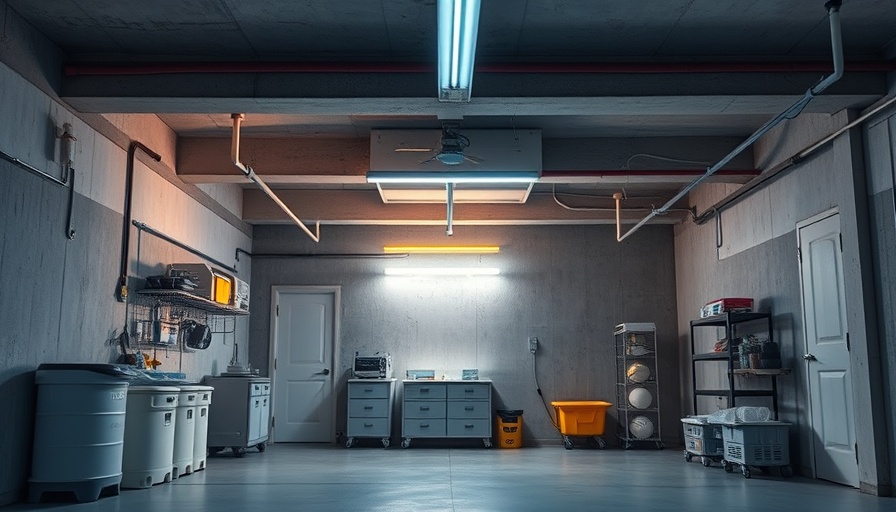
Decoding Basement Lighting: Understanding Your Options
The basement, often a forgotten area in many homes, holds tremendous potential for anything from cozy family rooms to functional storage spaces. Yet, the right lighting can make or break these areas. Understanding the characteristics of the two most popular lighting options—LED and fluorescent—can help Brooklyn homeowners transform their dimly lit basements into vibrant extensions of their living spaces.
The Basics of Basement Lighting: What You Need to Know
Before deciding on the type of light, it’s essential to grasp the basement’s unique lighting requirements. Basements typically lack natural light, making effective artificial lighting crucial for safety and ambiance. Homeowners should assess several factors such as brightness, energy efficiency, installation ease, and maintenance needs when choosing lights. These elements not only affect utility bills but can also influence the longevity of the lights.
LED Lighting: The Modern Solution for Basements
LED lighting has emerged as a top choice for basement spaces, praised for its energy efficiency and durability. Consuming significantly less power than fluorescent bulbs, LEDs offer substantial savings on electricity bills. With lifespans of over 25,000 hours, LEDs reduce the headache of frequent replacements, making them a reliable option for busy homeowners. Plus, the availability of various color temperatures means you can customize the atmosphere—from warm and cozy to cool and crisp—aligning perfectly with the desired usage of the basement.
Fluorescent Lighting: A Time-Tested Alternative
While LED lights are gaining popularity, fluorescent lights still have their merits. They typically provide a brighter light, which can be beneficial in larger or darker basements. Fluorescent bulbs can also be more cost-effective upfront than LEDs, making them appealing for budget-conscious homeowners. However, the trade-offs include shorter lifespan—around 7,000 to 15,000 hours—and issues such as flickering and the need for more frequent replacements, which can diminish overall savings in the long run.
The Environmental Angle: Sustainability Matters
As sustainability becomes a crucial consideration for many homeowners, the environmental impact of lighting options cannot be ignored. LED lights rank higher when it comes to sustainability, using less energy and having low emissions over their lifetime. Additionally, as they don’t contain mercury—unlike some fluorescent bulbs—LEDs pose less risk to the environment when disposed of. Selecting energy-efficient solutions is not only a smart financial decision but also one that supports global efforts toward sustainability.
Making the Right Choice: Factors to Consider
When weighing your lighting options, here are some critical factors to consider:
- Purpose: What will your basement be used for? The function may dictate the type of light needed.
- Size of Space: Smaller basements can thrive with the softer glow of LEDs or strategically placed fluorescents, while larger areas might benefit from brighter illumination.
- Budget: Consider both initial costs and long-term savings; while LEDs have a higher upfront cost, their longevity and efficiency can provide substantial savings over time.
- Maintenance: If you prefer minimal upkeep, LEDs may be the better option due to their longer lifespan.
Your Personality Meets Your Basement: Lighting as a Design Element
Lighting is more than a necessity; it's an integral part of a home's design. Think about how the light can change the feel of your basement. A well-lit space can make it feel larger and more inviting. If you enjoy entertaining, consider the mood you want to create with your lighting. Warmer tones can set a cozy atmosphere, while brighter whites can energize the space for activities or play areas. Your personality and lifestyle should guide your choice of lighting, as it can influence how you and your guests feel in the space.
Conclusion: Shine a Light on Your Choices
In making the right choice of lighting for your basement in Brooklyn, consider all the factors that will enhance your living space—not just in functionality, but also in how it reflects your style and contributes to your home's overall atmosphere. Don't rush the decision; take the time to evaluate both options against your specific needs. Your basement can transform from a shadowy corner of your home to a vibrant, useful part of your daily life.
Ready to upgrade your basement lighting? Explore your options today and discover how the right lighting can change the feel and functionality of this valuable space in your home!
 Add Row
Add Row  Add
Add 




Write A Comment